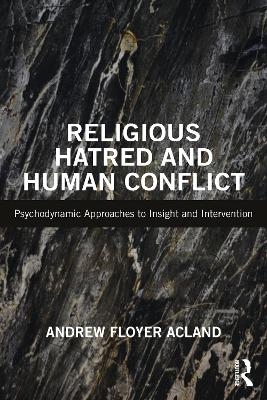
Religious Hatred and Human Conflict
Routledge (Verlag)
978-1-032-50050-8 (ISBN)
The book highlights six dimensions of religion: identity, doctrine and practice, emotion and experience, mythology, sacred values and power and control, exploring how these can give rise to religious hatred and lead to marginalisation, persecution and even genocide. It also explores reasons for the evolution of religion and religious hatred, and their relationship with human behaviour through contemporary issues such as fundamentalism, martyrdom, clerical narcissism and apocalyptic belief. Acland examines how religious hatred and conflict may be transcended by facilitating processes of dialogue and diapraxis which enable a systematic understanding of prejudices and projections. Last, it offers practical methods and strategies for helping individuals and communities grow beyond the constraints of religious hatred, treating religious hatred as a psycho-spiritual problem that requires self-understanding.
Identifying the implications for professionals in conflict resolution and mediation, politicians, community leaders, diplomats and anyone working to prevent or reduce conflict where religious belief is a factor, this book sets out how those tasked with intervening can respond to the challenges involved. It will also be highly relevant reading for students and researchers of psychology and religious studies.
Andrew Floyer Acland, PhD, has been an independent mediator and facilitator of dialogue in situations of conflict, most of them involving issues of beliefs and values, for over 30 years. Based in the UK, he has worked nationally and internationally with governments, businesses and civil society groups.
PART 1: Contexts and cultures
Chapter 1: Beginning, background and biases
Chapter 2: Three backstories
Conflict resolution and transformation
The psychology of religion
Psychodynamic psychology
Inspirational beginnings: Sigmund Freud and Carl Jung
Rehabilitating Jung
Beyond Freud and Jung
PART 2: What is religious hatred?
Chapter 3: Thinking about religious hatred
Anatomies of hatred
Hatred and evolution
Hatred and the Other
From hatred to genocide
Hatred and thoughtcrime
Religion and hatred as addictions
Chapter 4: Psychodynamic approaches to religious hatred
Complexes
Complexes and religious traditions
Cultural complexes
The Shadow
Complexes and Shadows in transmission
PART 3: Religious hatred and the dimensions of religion
Chapter 5: Six dimensions of religion
Dimensions of religion
The dimensions of religion, religious hatred and the problem of evil
Chapter 6: The identity dimension
Religion and identity
Conflicting religious identities and the idea of the "Other"
The narcissism of small differences
The Persona, the Shadow and the Other
Chapter 7: The doctrine and practice dimension
Religious doctrine and the Golem Effect
Fundamentalism
Fundamentalism, hatred and violence
The psychology of fundamentalist doctrine and practice
Groups and group practices
Fundamentalism as a form of cultural complex
Chapter 8: The emotional and experiential dimension
The missing dimension
Marks of religious experience
Emotions and religious experience
The psychology of religious experience
Religious hatred and the Divided Self
Healing the Divided Self
Religious hatred as the failure to individuate
Hatred and the Self
Chapter 9: The mythological dimension
Approaching mythology
Social impacts of myth
Impacts of myth on individuals
Mythology and religious hatred
Modern myths
Cosmic wars
When myth leads to martyrdom
The psychology of Armageddon
Mythmaking and scapegoating
Chapter 10: The sacred values dimension
The nature of sacred values
Sacred values and personal motivation
Valuing sacred values
Pseudo-sacred values
Secular values that turn sacred
Sacred values and religious hatred
Sacred values and uncertainty
Chapter 11: The power and control dimension
The impetus to control
Constraints as control
Compensatory control
Terror Management Theory
From control to paranoia
Control through clericalism
Evolution of religious control
PART 4: Working through religious hatred
Chapter 12: The search for answers
Understanding religion
Appreciating the emotional and unconscious
Beyond dialogue
Re-framing religious hatred as a psychospiritual problem
Incorporating the transcendent function
The practicalities of conflict resolution: dialogue and diapraxis
Diapraxis: process and structures
Using the dimensions of religion as a structure for dialogue and diapraxis
Afterword
References
Index
| Erscheinungsdatum | 14.09.2023 |
|---|---|
| Zusatzinfo | 1 Tables, black and white |
| Verlagsort | London |
| Sprache | englisch |
| Maße | 156 x 234 mm |
| Gewicht | 390 g |
| Themenwelt | Geisteswissenschaften ► Psychologie ► Sozialpsychologie |
| Mathematik / Informatik ► Mathematik | |
| Medizin / Pharmazie ► Medizinische Fachgebiete ► Psychiatrie / Psychotherapie | |
| ISBN-10 | 1-032-50050-6 / 1032500506 |
| ISBN-13 | 978-1-032-50050-8 / 9781032500508 |
| Zustand | Neuware |
| Haben Sie eine Frage zum Produkt? |
aus dem Bereich


